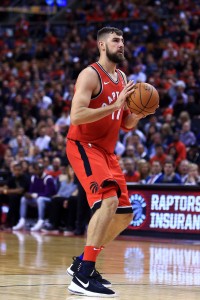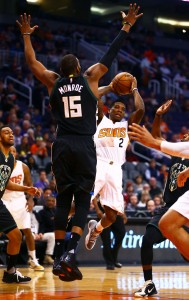NBA rosters will undergo some changes over the course of the 2017/18 season, particularly around the trade deadline, and those changes may have an impact on teams’ cap sheets for future seasons. Based on the NBA’s current rosters, however, we can identify which teams are most or least likely to have cap room in the summer of 2018, which will dictate the type of moves those clubs can make in the offseason.
We’ll be taking a closer look at each of the NBA’s 30 teams by division over the next week. Today, we’re starting with the Atlantic division. With the help of salary information compiled by Basketball Insiders, here’s how the summer of 2018 is shaping up for the five Atlantic teams:
Toronto Raptors
Guaranteed 2018/19 team salary: $124,628,430
Projection: Over the cap and into the tax
The Raptors have nearly $125MM in guaranteed money on their books for the 2018/19 season, easily the most of any Atlantic teams. If Toronto can’t clear any of that money of its cap, the club would almost certainly surpass the tax threshold, based on the latest cap projections from the NBA.
The most obvious way for the Raptors to create a bit of breathing room would be to find a taker for Jonas Valanciunas, who is due a $16.5MM salary next year. Still, Toronto has reportedly explored potential Valanciunas trades before and hasn’t found any viable options, so it won’t necessarily be easy for the Raps to move his salary. And even if they do, it would take more than that to get under the cap.
Boston Celtics
Guaranteed 2018/19 team salary: $104,650,766
Projection: Over the cap
The Celtics currently project to be a little over a $101MM cap, and they’d go even further beyond that threshold if they want to re-sign Marcus Smart or Aron Baynes, or retain non-guaranteed players like Daniel Theis. Even if Boston is willing to let those players go, there’s no obvious path to carving out a chunk of cap room, so the C’s figure to be an over-the-cap team.
Brooklyn Nets
Guaranteed 2018/19 team salary: $68,601,762
Projection: Up to approximately $28MM in cap room
Our cap projection for the Nets assume that the team hangs onto Spencer Dinwiddie, who has a non-guaranteed salary. However, it also assumes that Jeremy Lin will turn down his $12MM+ player option. Considering Lin will miss the rest of the season with a knee injury, there’s actually a good chance that he’ll play it safe and pick up his player option rather than taking his chances on the open market. In that scenario, Brooklyn’s cap space would be cut nearly in half.
New York Knicks
Guaranteed 2018/19 team salary: $68,004,397
Projection: Up to approximately $12MM in cap room
Why do we have the Knicks projected to have far less cap room than the Nets, despite both teams having nearly equal guaranteed salary? We’re assuming that Enes Kanter will exercise his $18MM+ player option for next season, as was reported back in August. Of course, nothing is official yet, and a big season for the Knicks could change the landscape for Kanter. But for now, it seems unrealistic to expect him to opt out.
New York’s projected cap room will be reduced further if Ron Baker and/or Kyle O’Quinn exercise player options of their own, which are worth about $4.5MM and $4.3MM, respectively.
Philadelphia 76ers
Guaranteed 2018/19 team salary: $56,928,155
Projection: Up to approximately $39MM in cap room
Even if we count on the Sixers exercising team options for T.J. McConnell and Richaun Holmes, the team should have a ton of flexibility. A Robert Covington extension would cut into that flexibility, but should still leave up to about $25MM in cap room. If the 76ers want to create enough space to sign a player to a maximum salary, finding a taker for Jerryd Bayless‘ expiring $8.6MM contract would likely be the first step.
Photo courtesy of USA Today Sports Images.


